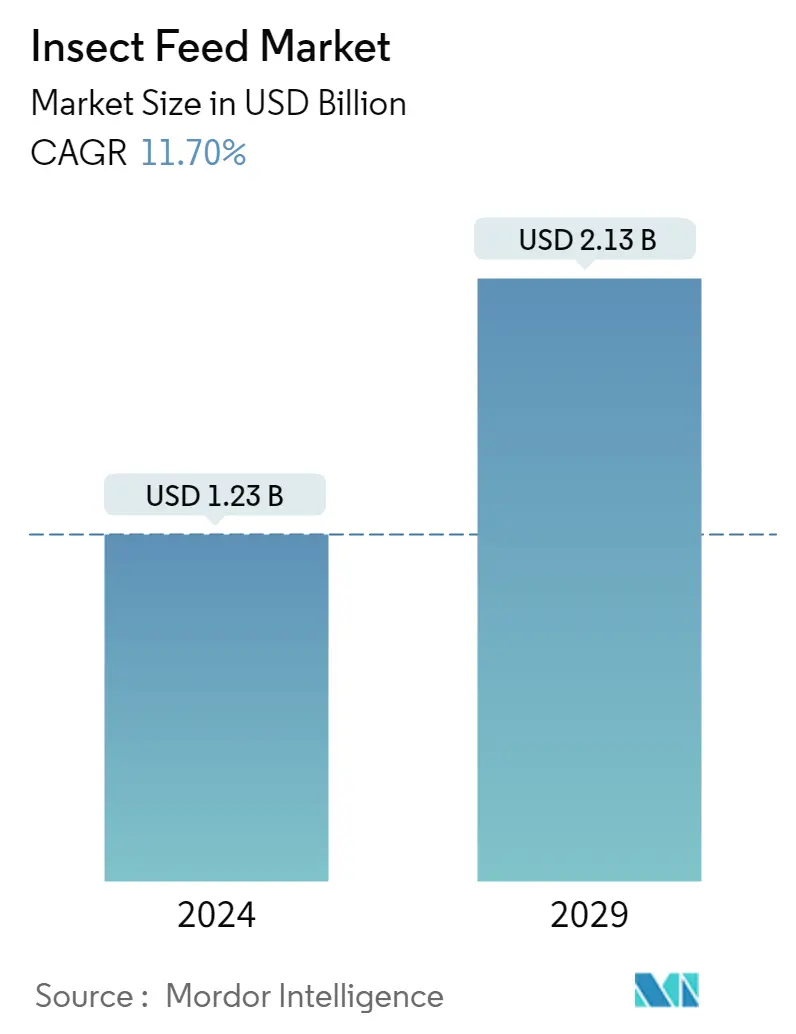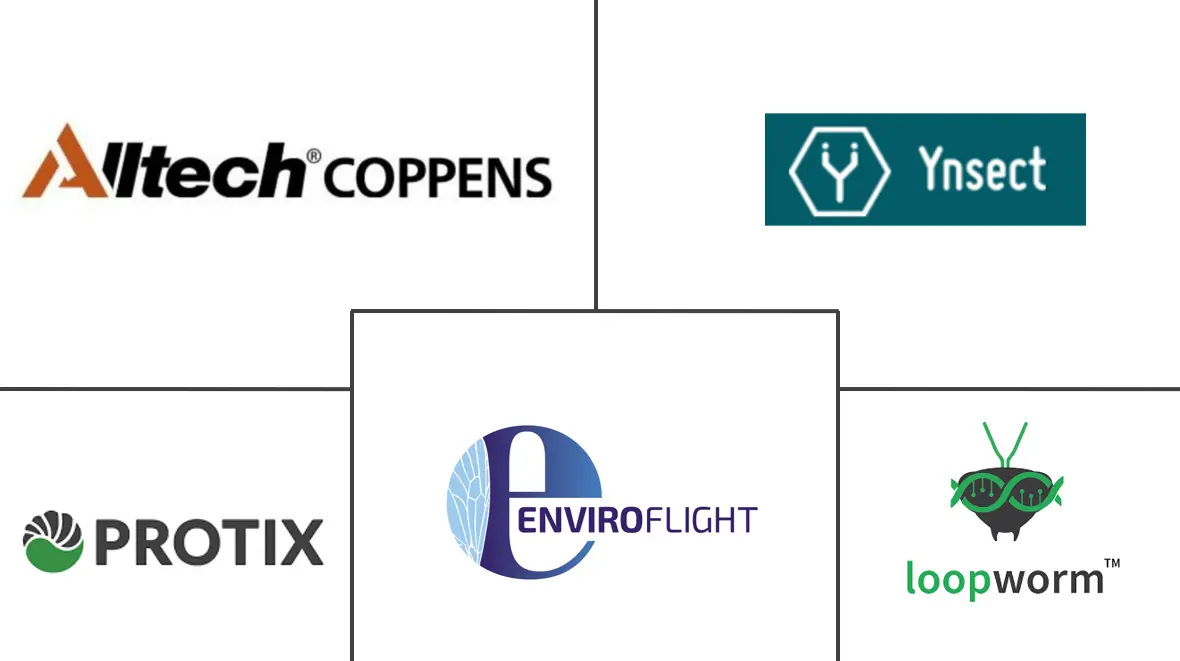Market Size of Insect Feed Industry

| Study Period | 2019 - 2029 |
| Market Size (2024) | USD 1.23 Billion |
| Market Size (2029) | USD 2.13 Billion |
| CAGR (2024 - 2029) | 11.70 % |
| Fastest Growing Market | Europe |
| Largest Market | Asia-Pacific |
Major Players
*Disclaimer: Major Players sorted in no particular order |
Insect Feed Market Analysis
The Insect Feed Market size is estimated at USD 1.23 billion in 2024, and is expected to reach USD 2.13 billion by 2029, growing at a CAGR of 11.70% during the forecast period (2024-2029).
- The insect feed sector, at present, has challenges, such as commercial-scale production, when compared to conventional animal feed products. However, major factors, including new investments by private venture capital (VC) firms in the insect feed market, were noted over the study period due to the market's rising demand on a global scale. For instance, in June 2021, KeyyakVenture, a Chilean venture capital firm, invested USD 4.5 million in Food for the Future (F4F), a start-up that manufactures insect feed that is situated in Chile. As a result, these VC companies' growing investments demonstrate their belief in expanding this market. Along with this, insects' high feed conversion ratio, low space requirements, supportive regulatory regulations, etc., are driving the insect feed market.
- Additionally, the increasing demand for farmed fish across the world led to a rise in the prices of fishmeal and fish oil. The insect feed serves as a viable protein-rich option for aquafeed. For the past 20 years, investigations have been carried out on insect meals as alternative sources for fishmeal. Thus far, the result of replacing fishmeal in feeding aquaculture species has been promising. Furthermore, as viable animal feed, insects have been receiving increasing recognition due to their high energy and protein content. The advantage of insect feed compared to fresh or unprocessed dried insects is that it can easily be mixed with other feed components, such as ground grains and soy, to form a mixture of the desired composition that is then pressed into pellets for better and more convenient feeding to animals.
- Also, insect feed enhances the immune system and reduces antibiotic use. Thus, it promotes animal health. Moreover, the poultry industry's usage of insects as feed is increasing. Feeding grasshoppers to chickens improves the shelf life of the meat. Using insect feed in the diet reduces feed costs and enhances the performance and health of broiler chickens. Thus, insect meal is an acceptable, inexpensive, and preferable source of protein for poultry. Thus, the maintenance of vast poultry by the farmers, along with other market drivers, is projected to boost the market during the forecast period.
Insect Feed Industry Segmentation
Insect feeds are meals enriched with high proteins blended from various raw materials and additives. These blends are formulated according to the specific requirements of the target animal, especially to use as an aquafeed. They are manufactured by feed compounders, such as meal types, pellets, or crumbles. For this report, only insect feed has been considered. The report covers an extensive study of segments and factors driving the growth of the commercial insect feed market.
The insect feed market is segmented by Animal Type (Aquaculture, Poultry, Swine, and Other Animal Types) and Geography (North America, Europe, Asia-Pacific, South America, and the Middle East and Africa. The report offers market sizing and forecasts in values in USD million for all the above segments.
| Animal Type | |
| Aquaculture | |
| Poultry | |
| Swine | |
| Other Animal Types |
| Geography | ||||||||
| ||||||||
| ||||||||
| ||||||||
| ||||||||
|
Insect Feed Market Size Summary
The insect feed market is poised for significant growth, driven by increasing global demand for sustainable and efficient protein sources. Despite challenges in commercial-scale production compared to traditional animal feed, the sector is gaining traction due to substantial investments from venture capital firms and the inherent advantages of insect feed, such as high feed conversion ratios and low space requirements. Insects are emerging as a viable alternative to fishmeal in aquafeed, addressing the rising costs of fishmeal and fish oil. Their high energy and protein content make them an attractive option for various livestock, including poultry, where they enhance meat quality and reduce antibiotic use. The growing recognition of insects as a nutritious and cost-effective feed source is expected to propel market expansion, particularly in the context of a burgeoning global population and the need for efficient protein production.
Regionally, the Asia-Pacific market, especially China and India, is witnessing robust growth in insect feed adoption. In China, the increasing meat consumption has spurred the development of the insect feed industry, with local companies focusing on self-sustainability by reducing reliance on imported soybean. Similarly, India is exploring insect feed to mitigate the high costs of conventional feeds and address the competition for agricultural resources. The global market remains fragmented, with Europe housing many key players. Companies are leveraging strategies like partnerships and expansions to enhance their market presence and drive research and development. The insect feed market's growth trajectory is supported by its potential to meet the rising demand for animal protein while offering environmental benefits, such as reduced greenhouse gas emissions and efficient feed conversion.
Insect Feed Market Size - Table of Contents
-
1. MARKET DYNAMICS
-
1.1 Market Overview
-
1.2 Market Drivers
-
1.3 Market Restraints
-
1.4 Porter's Five Forces Analysis
-
1.4.1 Bargaining Power of Suppliers
-
1.4.2 Bargaining Power of Buyers
-
1.4.3 Threat of New Entrants
-
1.4.4 Threat of Substitute Products
-
1.4.5 Intensity of Competitive Rivalry
-
-
-
2. MARKET SEGMENTATION
-
2.1 Animal Type
-
2.1.1 Aquaculture
-
2.1.2 Poultry
-
2.1.3 Swine
-
2.1.4 Other Animal Types
-
-
2.2 Geography
-
2.2.1 North America
-
2.2.1.1 United States
-
2.2.1.2 Canada
-
2.2.1.3 Mexico
-
2.2.1.4 Rest of North America
-
-
2.2.2 Europe
-
2.2.2.1 Germany
-
2.2.2.2 United Kingdom
-
2.2.2.3 France
-
2.2.2.4 Russia
-
2.2.2.5 Spain
-
2.2.2.6 Rest of Europe
-
-
2.2.3 Asia-Pacific
-
2.2.3.1 China
-
2.2.3.2 Japan
-
2.2.3.3 India
-
2.2.3.4 Rest of Asia-Pacific
-
-
2.2.4 South America
-
2.2.4.1 Brazil
-
2.2.4.2 Argentina
-
2.2.4.3 Rest of South America
-
-
2.2.5 Middle East and Africa
-
2.2.5.1 United Arab Emirates
-
2.2.5.2 Egypt
-
2.2.5.3 Rest of Middle East and Africa
-
-
-
Insect Feed Market Size FAQs
How big is the Insect Feed Market?
The Insect Feed Market size is expected to reach USD 1.23 billion in 2024 and grow at a CAGR of 11.70% to reach USD 2.13 billion by 2029.
What is the current Insect Feed Market size?
In 2024, the Insect Feed Market size is expected to reach USD 1.23 billion.

